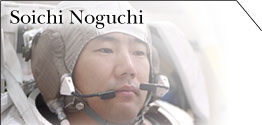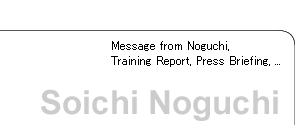Astronaut Noguchi's Training Report, #6
The search for Space Shuttle Columbia debris
Last Updated: August 5, 2003
Hello, everyone, I'm astronaut Noguchi.
It has already been two months since the Columbia accident. (This report was written in April 2003.)
We STS-114 crew members are working to support the bereaved families of the STS-107 crew members, and are receiving training to maintain our skills. We are also cooperating with the accident investigation activity.
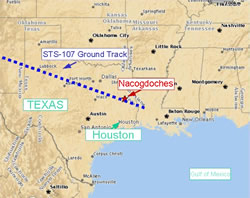 |
| Map of the recovery area |
As a part of this activity, we lately participated in the recovery of debris that was going on in Texas and Louisiana. The search we joined took place in the Nacogdoches forest, in eastern Texas. Nacogdoches is the largest part of the four recovery bases. It is also where the first debris was found just after the accident.
Up to 1,200 people are still searching for debris, finding new pieces every day. In total, over 60,000 pieces of debris have been collected so far, and it is equal to about 40% of the shuttle's total weight. This debris will be sent to Kennedy Space Center and investigated to determine the cause of the accident.
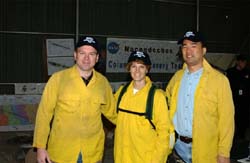 |
| With my recovery team members |
We left Houston early in the morning to fly to the Nacogdoches airport. After we arrived there, a forest ranger, a person in charge of safety, and a recovery team leader gave us explanations about the recovery. They were very cautious about safety during the search because there was a helicopter crash in the beginning of this month, and a worker had been bitten by a venomous snake during the search. We put on safety helmets, goggles, leather gloves, and protective clothing and headed for the forest to join the team.
A recovery team is usually composed of 20 members. The search site is decided in the morning at the debris search base. In the field, members make a row at intervals of 3 meters and walk side-by-side straight into the forest, following the orders of the leader. We just push our way through the woods according to our given route, even if there are swamps or fallen trees. The STS-114 crew members were positioned in the front. I joined a group including many Hispanic personnel, so the leader's orders were in Spanish. Examples, included "alto" for "stop," "mobiendoza" for "go," "diez pies" for "maintain 10 feet intervals." Once I got used to these phrases, I felt relaxed and talked to them freely. After all the preparations were completed, we set out toward the depth of the forest. We had an easy way for the first few minutes, but soon the deep woods blocked our way. We silently advanced in areas where no one has ever stepped. I was wrapped up in the thick protective clothing and carrying a backpack full of equipment. My goggles soon fogged up with sweat. The visibility was bad that I could hardly see searchers just 3 meters away from me. I caught my foot in a grassy place; the ground was muddy with rain that had fallen the week before. I almost lost my balance and fell. Walking like that in the forest made me realize that finding the debris under such conditions is not at all easy.
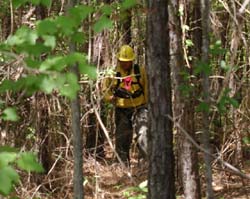 |
| Advancing in the deep woods |
About an hour later, a member who was right next to me found a piece of the thermal protection system (TPS) tile. It was about 20cm long and 5cm wide, and although it was stained with soot, it certainly was a piece of Columbia.
I was so glad that we were able to find it, but at the same time, I felt as though we were gathering the remains of Columbia. The tile had separated from the orbiter and fallen here, buried, deep in the woods, waiting to be collected. Looking up at the beautiful blue sky, I remembered that February 1 was a fine day just like this day. I imagined the crew seeing the same sky at the time of their death, and I prayed once again their souls might rest in peace.
We continued the search for about two more hours and returned to the meeting place. There, we met again with Captain Collins and Astronaut Kelly. Their team had had a hard time, and they had encountered a snake. It appeared that we were the only group to have found debris.
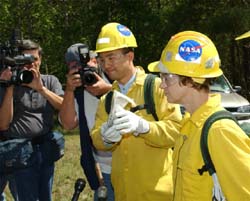 |
| Answering questions from the press at the meeting place |
By participating in the recovery efforts, I found out that this activity was far more a difficult work than I had expected. Immediately after the accident, it was fairly easy to collect debris; it's now getting harder and harder to recover pieces from in forests, or in water such as marshes and lakes. Yet, people are still continuing their recovery efforts, and this will lead to the determination of the cause of Columbia's accident. I thought I could never thank them enough. Numerous local volunteers were also cooperating to support our recovery efforts. When they found out that STS-114 was the next mission to be launched, they all encouraged us to return to flight, and this truly moved me. From the bottom of my heart, I felt that manned flight was supported by the efforts of numerous people, and it reinforced my determination to accomplish the coming mission successfully with all of my strength.
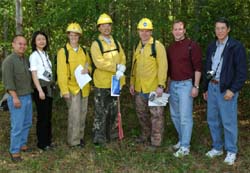 |
| With my crew members and recovery personnel |
